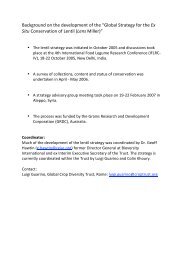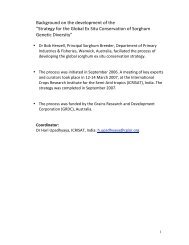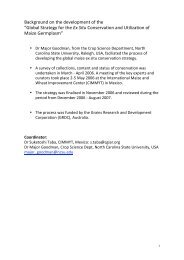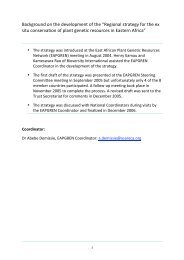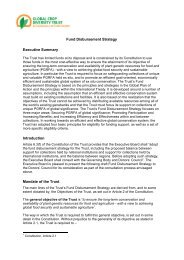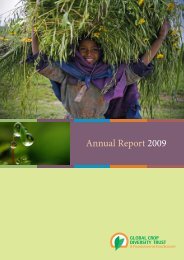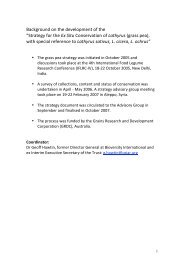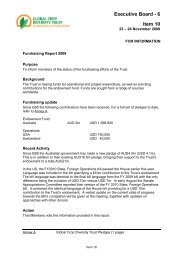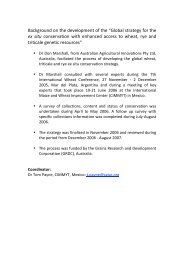Global Strategy for the Ex Situ Conservation of Potato - Global Crop ...
Global Strategy for the Ex Situ Conservation of Potato - Global Crop ...
Global Strategy for the Ex Situ Conservation of Potato - Global Crop ...
Create successful ePaper yourself
Turn your PDF publications into a flip-book with our unique Google optimized e-Paper software.
Lechnovich has been used, describing over 200 wild potato species. Spooner and<br />
Hijmans (2001), Hijmans et al. (2002), and Spooner et al. (2005) listed 199 different wild<br />
potato species (Solanum section Petota and three out group relatives <strong>of</strong> <strong>the</strong> section<br />
Etuberosum).<br />
2. Native cultivars, including local potato cultivars occurring in <strong>the</strong> centre <strong>of</strong> diversity. The<br />
two taxonomic schools describe eight (Hawkes, 1990) and 12 species (Russian<br />
taxonomists (Bukasov, 1971 and Lechnovich, 1971) respectively, with ploidy levels at 2x,<br />
3x, 4x, and 5x (x=12). Alternatively, Spooner and Hijmans (2001) distinguish seven<br />
species <strong>of</strong> native cultivars.<br />
3. Modern cultivars <strong>of</strong> <strong>the</strong> common potato (Solanum tuberosum subsp. tuberosum), <strong>the</strong><br />
most cultivated potato subspecies in <strong>the</strong> world. This genepool includes both old and new<br />
varieties.<br />
4. O<strong>the</strong>r germplasm or research material; all types <strong>of</strong> genetic stocks e.g. inter-specific<br />
hybrids, breeding clones, genetically enhanced stocks, etc.<br />
5.2 Data collecting<br />
The assessment <strong>of</strong> <strong>the</strong> state <strong>of</strong> <strong>the</strong> art <strong>of</strong> potato conservation at <strong>the</strong> global level is based on<br />
<strong>the</strong> analysis <strong>of</strong> 23 responses to a questionnaire. Thirty-five copies <strong>of</strong> <strong>the</strong> questionnaire were<br />
mailed to <strong>the</strong> same number <strong>of</strong> contacts (potato collection curators) in 30 different countries.<br />
Twenty-three contacts in 22 countries returned a completed questionnaire (66 %), which van<br />
be considered a high response. Approximately 90% <strong>of</strong> <strong>the</strong> global potato genetic resources<br />
holdings, including those <strong>of</strong> <strong>the</strong> six largest potato genebanks, was thus included in <strong>the</strong><br />
assessment. Besides general questions, questions related to <strong>the</strong> collection size and type <strong>of</strong><br />
material maintained, collection management procedures, conservation practices, evaluation<br />
and use <strong>of</strong> <strong>the</strong> germplasm, and policies with regard to access conditions were included. Data<br />
obtained from <strong>the</strong> 23 completed questionnaires have been compiled in 13 tables (Annex 4).<br />
In<strong>for</strong>mation obtained from <strong>the</strong> questionnaire was complemented by discussions wit<br />
respondents during <strong>the</strong> Lima workshop and in<strong>for</strong>mation obtained from potato networks and<br />
databases, as well as from <strong>the</strong> scientific literature.<br />
5.3 An analysis <strong>of</strong> major collections<br />
The 23 analysed potato collections contain a total <strong>of</strong> nearly 59,000 accessions (Table 1).<br />
Wild species <strong>for</strong>m <strong>the</strong> largest group <strong>of</strong> accessions, although it is known that <strong>the</strong>re is a high<br />
level <strong>of</strong> duplication in this group (see Table 2, Annex 5). Germplasm <strong>of</strong> <strong>the</strong> native cultivars<br />
from <strong>the</strong> centre <strong>of</strong> diversity in Latin America <strong>for</strong>ms a second major category. This germplasm<br />
is largely vegetatively conserved in field genebanks and in vitro collections, whereas in some<br />
collections held in regions outside Latin America <strong>the</strong>se native cultivars are maintained in <strong>the</strong><br />
<strong>for</strong>m <strong>of</strong> true seed.<br />
Detailed in<strong>for</strong>mation on <strong>the</strong> composition and size <strong>of</strong> <strong>the</strong> 23 collections is presented in Table 2<br />
(Annex 4).<br />
10




